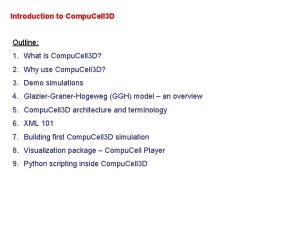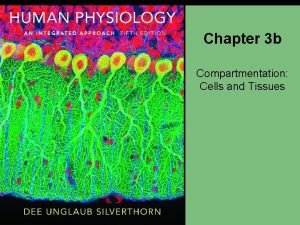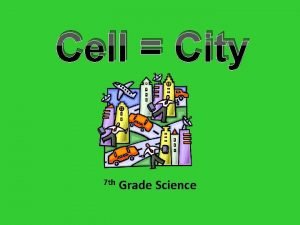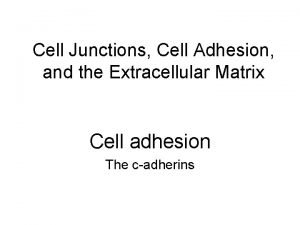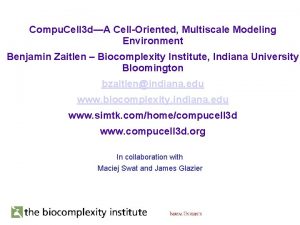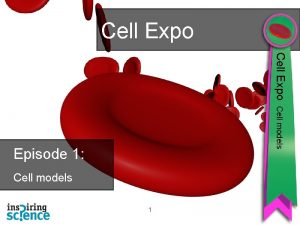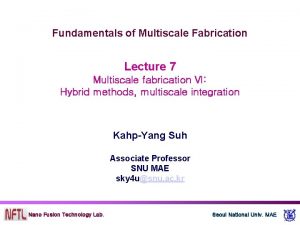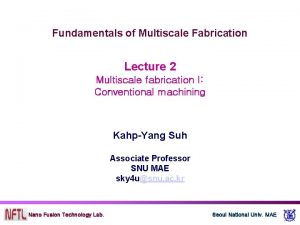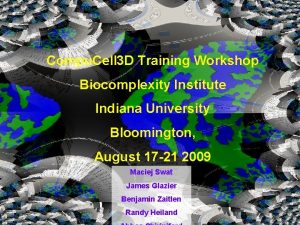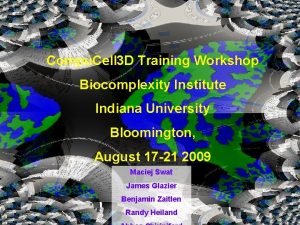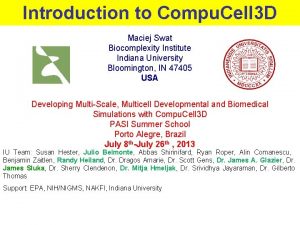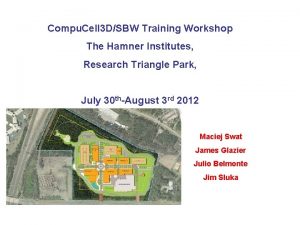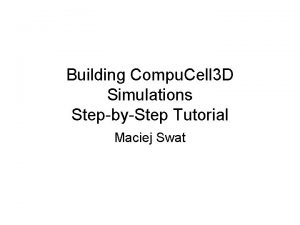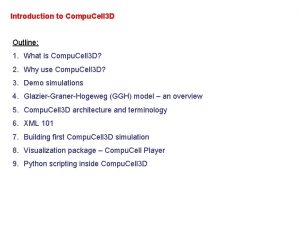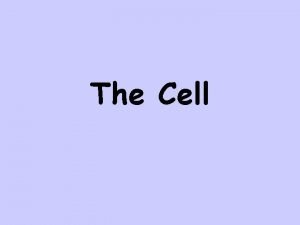Multiscale Models in Compu Cell 3 D A


































- Slides: 34

Multiscale Models in Compu. Cell 3 D Ø A Liver-centric Multiscale Modeling Framework for Xenobiotics Ø Leveraging SBML models for subcellular and whole-body scales This presentation is based on the work of; James P. Sluka*, Xiao Fu, Maciej Swat, Julio M. Belmonte, Alin Cosmanescu, Sherry G. Clendenon, John F. Wambaugh† and James A. Glazier Biocomplexity Institute, Indiana University † US Environmental Protection Agency 10 September 2015 jps

Modeling Workflow Biological Experiments Biological Observations Bio. Model Mathematical Model Validation Verification New Knowledge Computational Model Simulation Prediction jps 2

Cellular Potts Model (CPM) (aka Glazier-Graner-Hogeweg Model) • Energy formalism • Cell lattice • Thermodynamic trajectory (not an energy minimization) jps 3

Cellular Potts Model • Developed by James Glazier and Francois Graner • Represents single cell as a collection of pixels on a lattice (regular or irregular) in 2 D or 3 D. • Physics based. • Uses energy formalism to describe cell properties (usually in the form of constraints), cell-cell interactions and cells’ behaviors. • Stochastic not, deterministic • Very simple and intuitive. Mathematical complexity does not go beyond understanding second order polynomials. • Capable of representing cellular and subcellular structures • Relatively fast up to 10^5 cells on a single CPU. • Used by many labs around the world. • Drawbacks: Time has to be converted from simulation unit to physical unit. Lattice granularity determines level of details of simulated objects. Simulation parameters are not independent –changing one of them triggers changes in others • Software: Compu. Cell 3 D, Chaste, Simmune, Morpheus, Tissue Simulation Toolkit jps

Focusing on observable cellular behaviors Energy formalism of the CPM allows implementing cellular behaviors as additive terms of the Hamiltonian: + jps

Cellular Potts Model implemented in Compu. Cell 3 D (CC 3 D) • A library of Python/C++ modules that implement the CPM. • Core CPM modules coded in C++ for speed. • A helper app’s for: – building models (Twedit++) – execution GUI (Player) • Ability to import, control and run SBML models jps 6

Compu. Cell 3 D (batteries included) • Cross-platform, open-source environment for building and running multi-cell multi-scale simulations of tissues and organs • Written in C++ and Python • Describes models using combination of XML and/or Python • Parallel implementation on GPU’s and multi-core machines • Simulation-wizards, simulation editors, graphical interfaces, visualization tools, SBML solvers, and FE solvers (experimental support) included SBML tools can be used to generate SBML models that CC 3 D would run inside each cell jps

Biological scales and common computational modalities jps 8

A multiscale, liver-centric model jps 9

Divide and Conquer Build jps 10

Divide and Conquer Build SBML Compu. Cell 3 D SBML jps 11

Why Acetaminophen (APAP)? * APAP: • Is a leading cause of acute liver failure in the US. • The therapeutic index (ratio of toxic to therapeutic doses) is unusually small for an over the counter medication. • Is included in many formulations and often a patient isn’t aware that the use of APAP, in conjunction with a prescribed pain killer (like Percocet), leads to high and perhaps lethal APAP doses. • Is often used as the “poster child” compound for Drug Induced Liver Injury (DILI) studies. * Paracetamol in the EU jps 12

Subcellular reaction kinetic model for APAP metabolism: Chemistry jps 13

Subcellular reaction kinetic model for APAP metabolism: Equations jps 14

Subcellular reaction kinetic model for APAP metabolism: SBML model executed in COPASI This ratio is known from human ADME studies jps 15

Whole-Body Physiologically Based Pharmaco. Kinetic (PBPK) model jps 16

Whole-Body PBPK model: Equations jps 17

Whole-Body PBPK model: SBML model executed in COPASI jps Plasma concentration of APAP following a simulated 1. 4 g dose in a 70 Kg individual (line). Open symbols are averages for 9 Caucasian subjects, average body weight 68 Kg. (Note that this model includes a single first order ODE for APAP metabolism within the liver compartment. ) 18

Tissue (multicell) scale model Hepatocytes Venous Flow Red Blood Cell Arterial Flow jps Serum Portion 19

Tissue scale model: Diffusion and transfer The diffusion (PDE) model for the multicell scale sinusoid model. Transfer between each of the three cell, or pseudo-cell, types is described by this transfer map. Subscripts indicate that there are multiple cells of each of the types and transfer is calculated between all pairs of cells that are in contact at a particular instant. The paired arrows represent passive transport that equilibrates across pairs of cell types if they are in contact. Looped arrows represent passive transport between adjacent cells of the same type. The single arrow labeled "Active Transport" represents the Michaelis-Menten modeled import of APAP from serum into hepatocytes. jps 20

Tissue scale model: Model in Compu. Cell 3 D Simulation of a two second pulse of APAP being carried through the multicell sinusoid model. jps 21

jps 22

Replicates for; 1. APAP 2. APA-Glucuronide 3. APAP-Sulfate Complete Multiscale Model Three diffusing species; 1. APAP 2. APA-Glucuronide 3. APAP-Sulfate 1. Replicate in each of the 20 hepatocytes 2. “Well stirred” containers 3. Converts APAP to the three metabolites jps 23

Complete Multiscale model In a simulation step, the CC 3 D script sequences both the calculations it carries out directly as well as time stepping the linked SBML models. A computational time step cycle consists of: 1. Time step the PBPK models updating the quantities of APAP, APAPG and APAPS in each compartment of the PBPK module. 2. Fetch the quantities of APAP within "CArt" and "CGut" compartments of the PBPK model and calculate the concentration of APAP entering the inlet side of the tissue-level (CC 3 D) sinusoid module. 3. The CC 3 D model creates blood portions and RBCs representing venous and arterial flow that contain the amount of APAP (or APAPG or APAPS) based on the blood concentrations in the two blood flows in the whole-body PBPK models. 4. The CC 3 D model then simulates blood flow for a short period of time. 5. Numerically integrate the transfer of drug molecules at the interface of blood (serum portions and RBCs) and hepatocytes. 6. Time steps the subcellular SBML models within each hepatocyte, which generates new values for the per-cell concentrations of APAP and metabolites. 7. At the central vein terminus of the sinusoid the APAP (and metabolites) are returned to the "CVen" compartment exit of the PBPK module. jps 24

Complete Multiscale model jps 25

jps 26

Advantages of using existing tools and standards • Can use existing tools for model-– creation – execution – parameter fitting – etc. • Can re-use existing models • Can use the well developed annotation standards for the SBML models jps 27

Modify, and partially tune the whole-body model 12 12 10 10 Plasma APAP (ug/ml) ADME averages from 4 health fasted adults given 12 mg/kg orally as a solution. 8 6 4 R 2 = 0. 992 2 2 0 0 0 2 Time (hr) 4 6 0 0. 1 0. 2 0. 3 Time (hr) 0. 4 0. 5 Gastric emptying (9 minutes) jps Data from: Prescott, L. F. “Kinetics and metabolism of paracetamol and phenacetin. ” Br. J. Clin. Pharmacol. 10 Suppl 2, 291 S– 298 S (1980). 28

Modify, and partially tune the whole-body model Modify the whole-body PBPK model replacing the first order gut absorption ODE (left) with a Michaelis-Menten (saturable) ODE (right). jps 29

More realistic (and more computationally complex) liver lobule model PT Definition of nodes and edges: CAP SIN CV jps

Results for constant pressure condition: Pressure and Flow Profiles jps

Population modeling Assumed that each parameter in the multi-scale model is selected from a +/- 25% normal distribution about the parameter’s best fit value. Results for 839 simulated individuals jps Comparison of the average response (closed symbols) of the simulated population with the simulated individual from the population that deviates the most from the population average (open symbols). 32

Acknowledgments Support: – US EPA – NIH/NIGMS (including a U 01) – Indiana University – NSF – Falk Fund jps 33

Description of the Biology versus the Math/Code e. g. , Gene Ontology, KEGG Pathway Biological Description e. g. , SBML e. g. , FEBio, Compu. Cell 3 D MATLAB, C++, … jps Mathematical / Computational Description
 Compu cell
Compu cell Biomodels database
Biomodels database Compu groupe medical
Compu groupe medical Multiscale combinatorial grouping
Multiscale combinatorial grouping Multiscale modeling
Multiscale modeling Semi-modals
Semi-modals Cell-cell junction
Cell-cell junction Difference of plant cell and animal cell
Difference of plant cell and animal cell Cell contents assignment to a non-cell array object.
Cell contents assignment to a non-cell array object. Prokaryotic cell vs eukaryotic cell
Prokaryotic cell vs eukaryotic cell Cell structure and function graphic organizer
Cell structure and function graphic organizer Prokaryotic cell and eukaryotic cell
Prokaryotic cell and eukaryotic cell Cell city project
Cell city project Dry cell vs wet cell
Dry cell vs wet cell Cell cycle and cell division
Cell cycle and cell division Cell-cell junction
Cell-cell junction Cell wall cell membrane
Cell wall cell membrane Electrolytic cell picture
Electrolytic cell picture Carbohydrate side chain
Carbohydrate side chain Prokaryotic
Prokaryotic Idealized animal cell
Idealized animal cell Primary source batteries
Primary source batteries Biology.arizona.edu/cell bio/activities/cell cycle/01.html
Biology.arizona.edu/cell bio/activities/cell cycle/01.html Plant and animal cells venn diagram
Plant and animal cells venn diagram Which organelle prepares proteins for specific jobs
Which organelle prepares proteins for specific jobs Cell city project animal cell
Cell city project animal cell 10 cm dish surface area
10 cm dish surface area Flexible covering of an animal cell
Flexible covering of an animal cell The scientist mathias schleiden studied _______ in ______.
The scientist mathias schleiden studied _______ in ______. Animal vs plant cell
Animal vs plant cell Walker cell and hadley cell
Walker cell and hadley cell Difference between plant and animal cell
Difference between plant and animal cell Tonoplast
Tonoplast Function of the cell wall
Function of the cell wall Mitosis
Mitosis
